On our way back from the Pyrenees we had a two night stopover. You may be able to guess where from this photo of a heavily over restored medieval bridge.
I am glad we visited, but I wouldn't make it the focus of a holiday.
On our way back from the Pyrenees we had a two night stopover. You may be able to guess where from this photo of a heavily over restored medieval bridge.
I am glad we visited, but I wouldn't make it the focus of a holiday.
We returned from our holiday yesterday, and have decided that Cauterets is the perfect place for us to visit. Neither of us are much into beaches and we both like mountain scenery.
Three years ago we went to Switzerland (read all about it here) and really enjoyed it. The scenery was excellent, as was the mountain driving, but neither of us particularly enjoyed the food, whereas Cauterets is a proper small French town with good restaurants and shops, and prices which are more or less what we would expect to pay at home. It also benefits from being a 19th century health resort with traditional architecture, rather than concrete monstrosities designed to cram as many skiers as possbile into the smallest of spaces.
Here are some pictures:
Bread has been a staple in France for centuries, and central France is the biggest producer of wheat in Western Europe.
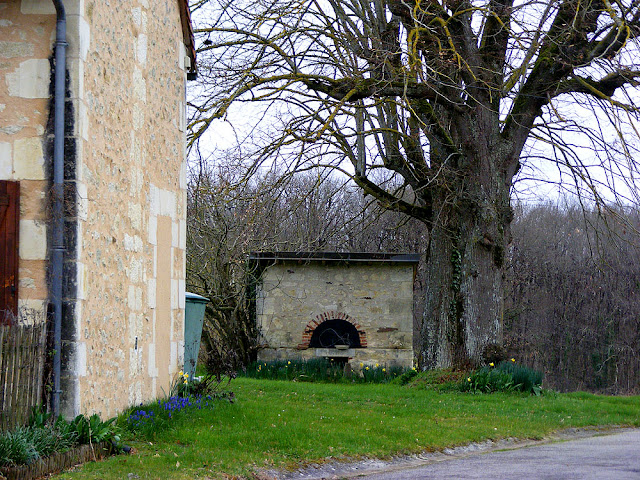
|
| An old bread oven in a farm house garden. |
In the 19th century rural houses often had a separate little building that contained an
oven for the household that would have been used on a daily basis. The oven
was a brick dome surrounded by a fairly standard limestone and terracotta
hut. It was constructed away from the dwelling because of the risk of fire.
Every day a wood fire would be lit inside the dome and once reduced to coals
the embers would be pushed aside and the day’s loaves put in, directly on
the brick base of the oven. Today if you live in a house with one of these
ovens you have likely renovated it and cook pizza in it.

|
| The ruins of a bread oven next to an abandoned salt smuggler's hideaway in the forest. |
If you lived in or near a village in feudal times then you were obliged to
use the four banal, the communal oven, which was owned by the local lord, who charged a fee
for access to the oven. The lord was responsible for the maintenance of
the oven, and he had to make sure that bread was baked perfectly,
otherwise he was fined. But on top of taking one sixteenth of his
peasants’ grain production as a general tax, he took another one sixeenth
as a fee for the use of the four banal. In addition, the lord would have
owned the mill where everyone had to get their wheatground into flour.
Those who lived close to the oven were disturbed by the endless comings
and goings as well as the noise and heat of the oven or ovens. Those who
lived further away were annoyed that they could make the most perfect
dough, but by the time they had brought it to the oven in summer it had
over proved and by the time it arrived to be baked in winter it was too
cold. The baker put in charge of the communal oven had to be available day
and night in case someone turned up to bake their bread.

|
| A nicely restored bread oven in a farm house garden. |
The first four banal appeared in the Middle Ages in Paris near the Tour Saint Jacques, and they quickly spread throughout France, in populous communities becoming huge complexes with enormous and multiple ovens. These fours banaux are similar to the smaller private ones in construction and use. Not just bread could be cooked in these ovens, but gratinée style side dishes of vegetables would commonly be placed in the oven to brown and cook in the cooling bread oven after the loaves had been extracted. If you ever see a dish on a modern menu that is something a la boulangere, it will be one of these homely comforting old meals.

|
| The bread oven in a friend's barn. |
After feudalism ended in France commercial bakeries started springing up
everywhere and the
boulangerie, named after the traditional round
boule
loaf, was born. At first they had big brick ovens and baked all the same
breads that everyone had always baked at home. They would also take
housewives’ gratin dishes and cook them at the end of the baking day, for
a small fee, as at this time many village houses did not have ovens at all
and were cooking on stoves.

|
| A bread oven attached to a friend's barn -- mostly renovated, but still with a fig tree growing out of it. They are undecided as to whether the oven or the fig tree will win. |
At the beginning of the 20th
century a technological change meant that ovens changed. The
baguette
had been introduced, and it required a steam injection oven. Today that is
what most bakers still use, to give their bread that crunchy crust we’ve
all come to expect, and most have switched over to gas or electric rather
than wood fired. But the heavy stone or brick bases of the ovens remain,
as by law in France, certain traditional breads must be stone baked the
old fashioned way, resting directly on the hot base of the oven and not on
a tray or a shelf.
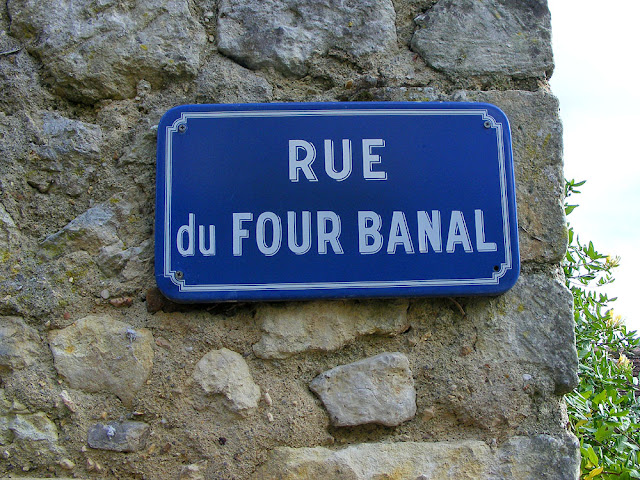
|
| Most towns and villages have a rue du Four Banal. |

|
| The oven in a troglodyte cave, fired up on a village fete day. Some tomato sauce made by the chefs at the Michelin starred restaurant and pizzas are in the oven. |
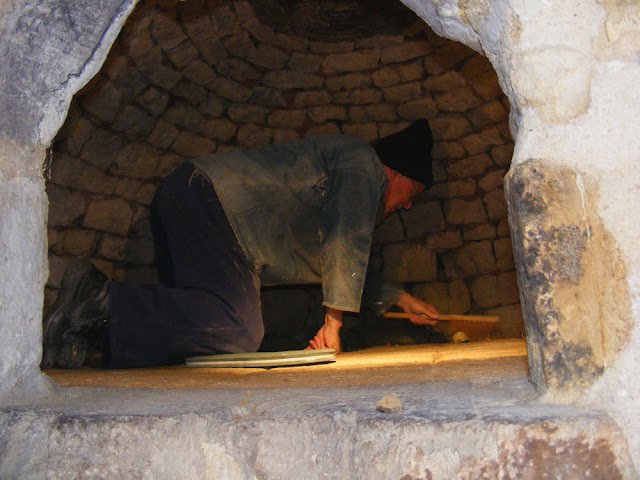
|
| My friend John sweeping out the large oven in our village's chateau gatehouse. |

|
| A nicely restored oven at a local potter's place (used for pizza not pots). |
This is what Spain looks like without selfie-takers:
Yesterday we continued our walking. We caught the shuttle bus from Cauterets to Pont d'Espagne, then the cable car and ski-lift and a 15 minute walk (discounting entomological breaks) to Lac de Gaube, where we lunched.
The hotel restaurant at Lac de Gaube is quite a surprise. Although the 20euro per person menu was basic, the food was good (and the tarte citron was excellent) and in many restaurants you would pay a lot more than 20euros just for the views.
The path back to Cauterets was extremely technical, the shale of Thursday having been swapped for granite boulders that required a fair amount of scrambling. It is called the Chemin des Cascades, and follows the river downhill - except where there have been rockfalls, where the path climbs before dropping to the river again,
In all we walked a little over 11km, with a descent of 840 metres. The path was quite challenging in places, as I hope the photos show.
After Thursday's walk we took some time to recover: we both had extremely sore calf muscles and were having difficulty walking upright. That meant that on Friday we led a very sedentary life, not straying much further than the boulangerie or a restaurant for dinner.
Yesterday we decided to test how our legs were recovering with a walk to lunch of about three kilometres along a fairly level track.
We found an excellently inexpensive restaurant, la Cascade, at Raillere. We ordered the 13€ menu main and dessert, and a half litre of rosé. My main was the "assiette des cyclistes" shown above, and Susan had an excellent burger. We both had Myrtilles and Fromage Blanc for dessert.
After lunch we took a slightly more challenging route back to Cauterets, passing a number of waterfalls. This is the restaurant we ate at from the bridge over the Cascade du Lutour.
The path was very picturesque, with the sort of views that might make Lord Byron faint with joy.
When we reached Cauterets we were amazed to find that we were only 30 metres from the church - but looking down on its spire. It then took another 15 minutes of "lacets" (switchbacks) to get down to the town. This is a very vertical area!
When your apartment is situated between a very good boulangerie and the local produce market, and the balcony has a view, who needs Michelin stars?
 |
| The Eiffel Tower at dusk, photographed from Trocadero. |
The Eiffel Tower was constructed for the 1889 World Fair. Today it's the most visited paid entry monument in the world, with 7 million visitors annually. But more or less everyone at the time it was constructed hated it. It was derided as skeletal, as if it was just the framework for an unfinished building. It was a 'skyscraper' in a low rise city. It was metal, in a city built of white limestone. So unattractive that 'even the Americans wouldn't stomach it'. It was so reviled that it took 70 years for permission for another skyscraper to be built to be granted. That was the equally reviled Montparnasse Tower, which is still considered a blot on the landscape. It does claim, with some justification, to have the best views in Paris though.
 |
| The Eiffel Tower, from the other side of the Seine, in flood and threatening nearby houseboats. |
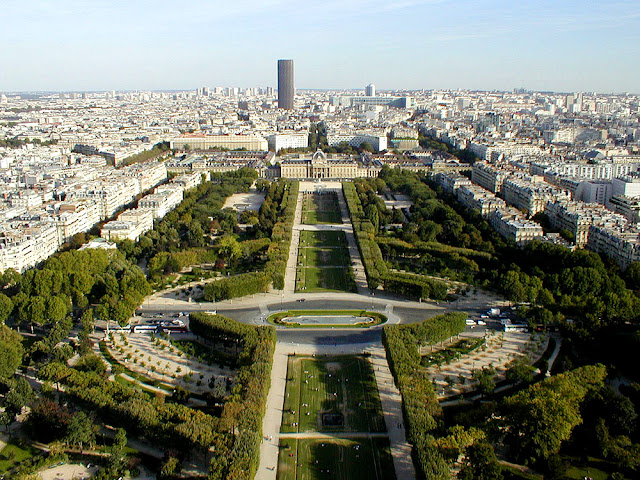 |
| The mid-20C Montparnasse Tower in the distance, photographed from the Eiffel Tower. You can see why the Montparnasse Tower is not loved. |
Yesterday we went for a walk down a hill, We caught the cable car and ski-lift up to Cirque du Lys (2300 metres) and walked back down to Cauterets (970 metres) in 30C plus heat. It was tiring but interesting; a walk of 12km, downhill on a combination of sheep paths and shale scree roads. Being so high, there was no shade, so we were pretty rung out by the end of it.
We got taken to a rather extraordinary site today, one that we didn't even know existed, despite having lived in the area for more than a decade.
 |
| A calvary, constructed of reinforced concrete. |
It is a faithful copy of the grotto at Lourdes, built in the 1860s out of reinforced concrete, hidden away in the woods in the park of the Chateau of Paulmy, 20 kilometres away from where we live.
 |
| The basin. |
The grotto was commissioned by Gertrude Stacpoole, Marquise d'Oyeron, just a couple of years after the original sanctuary was created, and made by a master rocailleur (landscape scale artificial rock artisan) from Tours. She had visited Lourdes often, and so decided to have her own version made. In addition to the grotto there are rustic bridges crossing the carefully landscaped stream, a circular basin and a mound that acts as a calvary.
 |
| Bridge with faux wood rails and a cascade. |
The site now belongs to the municipality of Paulmy, but can't be accessed without permission. These days it is like walking into an ancient Mayan site, barely cleared of the encroaching jungle. Fallen trees lie at all angles, victims of a hurricane in the 1990s.
 |
| The replica shrine, with a mature oak tree fallen on it. |
Gertrude, who was the daughter of a duke, came from a fabulously wealthy but disfunctional Anglo-Irish-French family. Her father abandoned his English wife and numerous children in Rome. He then went on to set up home with a couple who were close friends in England and left the bulk of his fortune to them. Much of his collection of art and fine objects is now in the Wallace Collection in London. Gertrude married Auguste Fournier de Boisaigrault, who inherited the Chateau of Paulmy estate, and whose mother was a member of the powerful Voyer d'Argenson family, who owned multiple grand properties around Les Ormes.
A stained glass window made at the end of the 19th century by the famous Tours based artisan Lux Fournier depicting the grotto can be seen in the church in Paulmy. There was an annual pilgrimage to the shrine on 15 August from 1885 to 1955, which several thousand people participated in. I was interested in how much at pains my French companions were to let me know that this was a Catholic tradition and not something they knew much about.
 |
| The stream is divided to create islands, with the shrine in the background. |
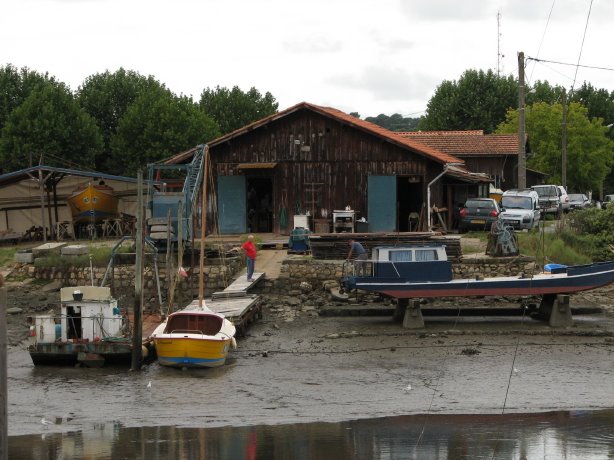 |
| An oyster producer in the Arcachon basin on the Atlantic coast. |
There are four main varieties of oysters to look out for:
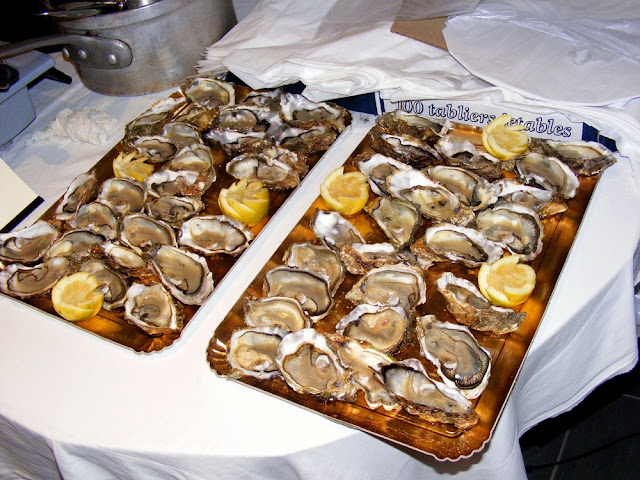 |
| Oysters au naturel prepared by Cédric the sous-chef at the Hotel Clos d'Amboise. |
 |
| An historic painted tile panel in Tours train station. Once upon a time you could catch a train from Tours to Arcachon. |
 |
| Oysters au naturel prepared by me for an al fresco lunch. |
La Pousse en Claire ('the saltmarsh grown'): A little gem from the Charentes, protected by a Label Rouge certification, this is the most desirable variety, unlike any other. Raised from 4 to 6 months in shallow water, only 2 to 5 oysters per square metre, they acquire an almost crunchy firmness. Generously filling out their semi round shell they have a mild sweet taste. If you find them, eat them as they are, as they need nothing to enhance them.
 |
| The flotilla of oyster boats heads out to the oyster beds from Bourcefranc, in the Marenne Oléron marine park. |
 |
| A big fat oyster from the market at Ars-en-Ré, probably the best I have ever eaten. |
 |
| Oyster producers' huts on the Ile d'Oléron. |
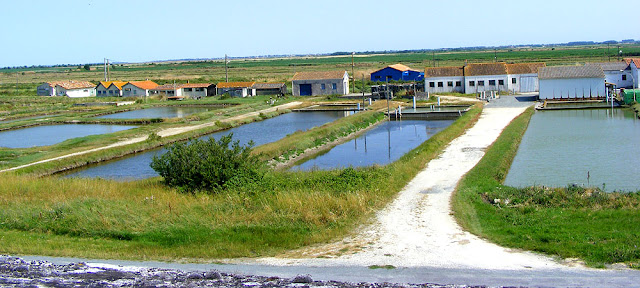 |
| Claires, or oyster finishing ponds in the Brouage saltmarsh. |
 |
| Me opening No 2 Speciales (large saltmarsh finished oysters) in our freezing cold kitchen before we renovated. |
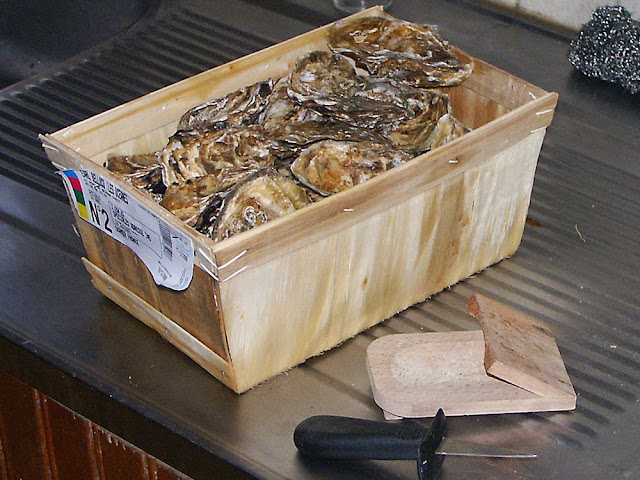 |
| A 3 kg (3 dozen) box of No 2 speciales, with opener. |
 |
| No 2 Oysters from the islands off the coast of the Atlantic coast, brought 2 hours inland to Preuilly sur Claise in the Touraine Loire Valley for the Saturday market. €5.40 a dozen. |
 |
| Oyster beds on the Ile de Ré. |